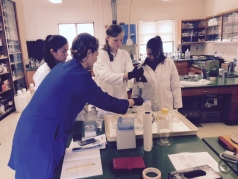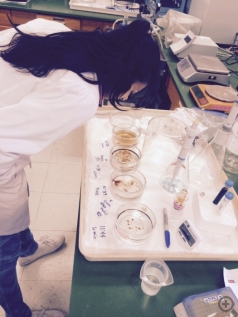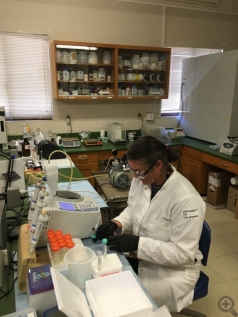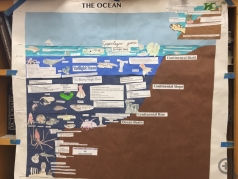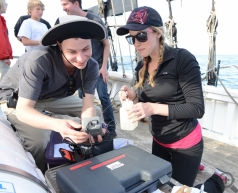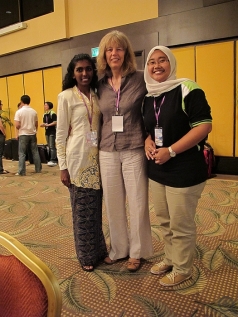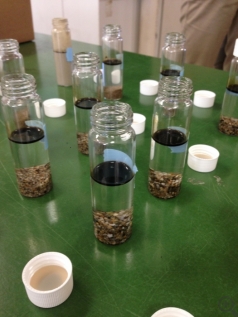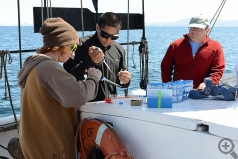To me outreach and education means sharing my expertise, enthusiasm and awe:
For their final project in Science, three 11th grade students from Rio Mesa High School, Camarillo tested the impact of oil on brine shrimp at our lab. The students observed how the swimming behavior of four brine shrimp changed in the presence of oil and varying amounts of Corexit, the dispersant used after the Deepwater Horizon spill in the Gulf of Mexico in 2010. Corexit is meant to mediate the oil spill damage by dispersing the oil. The target addition of Corexit to spilled oil in the GoM was 1/20th of oil. In the experiment students exposed the brine shrimp to the control to seawater only, and the four treatments each contained 1 mL of oil (added to 100 mL of water) and 0µL, 10µL, 50 µL or 100µL of Corexit. The students found that the oil and the swimming behavior changed depending on the amount of Corexit added.
Class entitled: Research at Sea: A Tall-ship Adventure Exploring Spatial Variability in the Santa Barbara Channel, introduces 20 undergraduates to oceanography and the effects of ocean acidification or oil spills, and culminates in a two day field trip on the schooner Bill of Rights. We have reached 120 students with this class.
A class on Ocean Acidification for Osher OLLI - the Lifelong Learning Institute at California State University Channel Islands. Many curious minds over 50 made this experience really fun!
Mentor to high school students from San Marcos High School
Ava, sophomore at San Marcos High School in Santa Barbara asked: What affect does OA have on humans and how we live our lives?
Jonathan answers: This is a tricky question as all humans live their lives differently with some people more directly affected by changes to the ocean than others. For example, the folks at Whiskey Creek Shellfish Hatchery in Tilamook, Oregon and local commercial urchin fisherman Bruce Steele who operates his business of the Santa Barbara coast are both at risk of losing their businesses as a result of ocean acidification. The average human, like me or you however, will not be drastically affected by changes in ocean chemistry other than maybe not having access to the seafood that we might enjoy, such as oysters, clams, and even Pacific salmon.
The term acidification sounds like an extreme change in ocean waters that could leave hot boils running up and down your legs after going for a swim, but in reality, the ocean is likely to remain relatively neutral (> 7.0 pH) throughout the end of the century. Surface water currently has an average pH of around 8.0. Scientists are more worried about ocean acidification from the standpoint of losing biological diversity and changing big picture processes that control other factors such as global warming and burial of carbon in the deep waters of the ocean. The ocean acts as a giant sponge for much of the carbon dioxide in the atmosphere and has already taken up 1/3-1/4 of the carbon dioxide emitted through human activity since the industrial revolution.
Without removal of carbon dioxide from the atmosphere, the Earth would be a very different place. For example, the ocean is responsible in large part for the production of breathable oxygen in the atmosphere and local weather patterns, both of which could be impacted by changes in ocean processes. When taken together with global warming, ocean acidification is an extremely dynamic issue that could dramatically alter the way in which we live beyond our diets; however, oceans could also already be adapting and changing to a new ‘normal’ level. If you grow up not experiencing the deliciousness of freshly caught seafood, then you probably would not think twice about declining oyster populations. It is all a matter of perspective.
How does OA affect our marine life?
That is a great question and one that scientists have been striving to answer since the issue of ocean acidification was first discovered. Unfortunately, there is no simple answer. Because the ocean is so vast and there are so many interconnected processes that are potentially adapting to change, scientists are forced to investigate little pieces of the puzzle that is ocean acidification, one at time. For example, ocean acidification is thought to increase the growth of some phytoplankton but not others and it is expected to decrease the shell thickness of some organisms but would then give a second group of better adapted organisms or even a close relative of the thin shelled organisms a chance to thrive. Overall though, the scientific community is agreed that ocean acidification will have an ultimately negative influence on marine life. Many organisms are not adapted to low pH environments and could experience heavier mortality or weaker morphology as a result. There is always hope, however! Some places, like the Santa Barbara Channel experience an oceanographic phenomenon known as upwelling which brings nutrient rich, low pH waters to the surface from depth during particular times of the year. We can infer from this natural process that organisms are already finding a way to deal with low pH water and surviving despite the harsh conditions. If these populations are currently experiencing the conditions that are predicted for the future ocean and continuing to survive, then they might not be in as bad of shape as we think.
Mentor to high school teacher, interning in the lab during the summer http://www.mrl.ucsb.edu/education/ret-research-experience-teachers/catherine-borgard#
Public Outreach examples include presentations on ocean acidification to
- volunteers of the Channel Islands Marine Sanctuary (NOAA) (Understanding Ocean Acidification Workshop)
- to teachers in Penang, Malaysia (GIFT, European Geophysical Society, EGU) (Penang 2011 GIFT Workshop - Ocean Acidification)
- Webinar for Climate Stewards (NOAA)
- Presentation on the oil spill to the interested publicat the 7th annual Poe symposium: Hurricanes Po Boys and Tarballs
- Interviews by journalists and reporters (National Geographic Daily News).
See 20 talking points of OA:
See National Park Service tide pool monitoring for climate change video:

